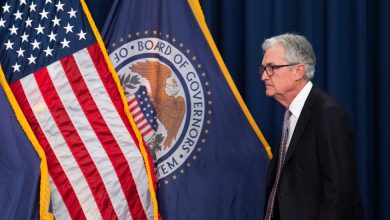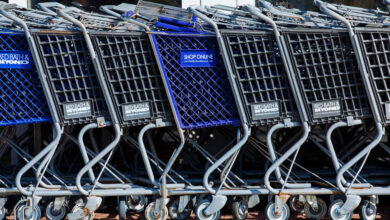The Week in Business: Guns vs. Economic Sanctions

What’s Up? (Feb. 27-March 5)
Economic Warfare
More than one million people have fled Ukraine since Russian troops moved in. Much of the response from Western countries has been economic. The United States, the European Union, Britain and other nations agreed to remove Russia from the SWIFT financial messaging system, essentially barring the country from international transactions, and impose restrictions on its central bank. The sanctions seem to have had an immediate effect on Russia’s financial situation: The ruble crashed, Russia’s stock market froze and Russians rushed to withdraw cash. Businesses also took aim at Russia’s economy. Oil companies said they would exit investments in Russia; H&M and Apple paused sales in the country; and Disney and Warner Bros. said they’d pause theatrical movie releases.
State of the Union
President Biden began his first State of the Union address on Tuesday by condemning Russia’s invasion of Ukraine and rallying support for Ukraine. He then turned to domestic issues, including the economy. In particular, he highlighted his plan for fighting inflation, which he called a “top priority.” It includes strengthening competition between companies, expanding work force opportunities and fixing the broken supply chain. (Some economists doubted that these efforts would be enough to tamp down price growth, which is primarily the Federal Reserve’s job.)
A Strong Jobs Report
U.S. employers added 678,000 jobs in February, the Labor Department reported on Friday. The economy still has about two million fewer jobs than before the pandemic, but job recovery has been steady despite new waves of the coronavirus. Employers have added at least 400,000 jobs every month since May. The report also showed gains in the number of adults participating in the labor force. The solid job gains, along with declining numbers of coronavirus cases, have made some forecasters optimistic that the economy is on a path back to something closer to normal.
What’s Next? (March 6-12)
A New Pandemic Playbook
President Biden unveiled a new coronavirus response strategy on Wednesday. The plan is aimed at moving the United States to a new phase of the pandemic in which the virus does not disrupt everyday life. It includes proposals that could help businesses manage the coronavirus’s risks, such as giving businesses tests, developing a checklist that businesses can use to manage air safety and asking Congress to revive a tax credit, offered early in the pandemic, for paid leave during Covid-related work absences. The question is whether Congress will approve funding for the plan. On Wednesday, Mr. Biden asked Congress to provide $22.5 billion.
Prices Rose, but How Much?
On Thursday, the Department of Labor will report how much prices increased in February. In January, the Consumer Price Index, an important measure of inflation, showed that prices were rising at their fastest pace in 40 years. Jerome H. Powell, the Federal Reserve chair, has signaled that the central bank will begin raising interest rates at its March meeting. On Thursday, he told the Senate Banking Committee that the Fed remained committed to using its tools to rein in inflation, and earlier in the week, he told the House Financial Services Committee that the economic uncertainty created by Russia’s invasion of Ukraine had not changed the Fed’s plans.
China’s Congress Begins
China’s legislature opened its weeklong annual session on Saturday. Chinese leaders are expected to use the event to pledge that China’s slowing economic growth will regain momentum. They may also hint at how China plans to ease its stringent pandemic restrictions. But the war in Ukraine is unlikely to be addressed. Beijing’s stance so far has been that both sides should hold talks, and its top banking regulator said last week that it would not join sanctions on Russia.
The Russia-Ukraine War and the Global Economy
Rising concerns. Russia’s attack on Ukraine has started reverberating across the globe, adding to the stock market’s woes and spooking investors. The conflict could cause dizzying spikes in prices for energy and food, and severely affect various countries and industries.
The cost of energy. Oil prices already are the highest since 2014, and they have jumped as the conflict has escalated. Russia is the third-largest producer of oil, providing roughly one of every 10 barrels the global economy consumes.
Gas supplies. Europe gets nearly 40 percent of its natural gas from Russia, and it is likely to be walloped with higher heating bills. Natural gas reserves are running low, and European leaders have accused Russia’s president, Vladimir V. Putin, of reducing supplies to gain a political edge.
Food prices. Russia is the world’s largest supplier of wheat and, together with Ukraine, accounts for nearly a quarter of total global exports. In countries like Egypt and Turkey, that flow of grain makes up more than 70 percent of wheat imports.
Shortages of essential metals. The price of palladium, used in automotive exhaust systems and mobile phones, has been soaring amid fears that Russia, the world’s largest exporter of the metal, could be cut off from global markets. The price of nickel, another key Russian export, has also been rising.
Financial turmoil. Global banks are bracing for the effects of sanctions intended to restrict Russia’s access to foreign capital and limit its ability to process payments in dollars, euros and other currencies crucial for trade. Banks are also on alert for retaliatory cyberattacks by Russia.
What Else?
Major League Baseball canceled games amid a labor dispute. Amazon said it would shut down 50 brick-and-mortar stores. Apple is expected to unveil a lower-cost version of its iPhone. And attendees of the CERAWeek energy conference, which kicks off this week in Houston, should have plenty to talk about as oil prices climb.





